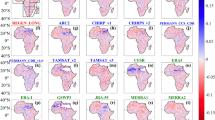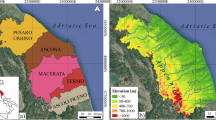Abstract
This paper presents an extensive validation of the combined infrared/microwave H-SAF (EUMETSAT Satellite Application Facility on Support to Operational Hydrology and Water Management) precipitation product H03, for a 1-year period, using gauge observations from a relatively dense network of 233 stations over Greece. First, the quality of the interpolated data used to validate the precipitation product is assessed and a quality index is constructed based on parameters such as the density of the station network and the orography. Then, a validation analysis is conducted based on comparisons of satellite (H03) with interpolated rain gauge data to produce continuous and multi-categorical statistics at monthly and annual timescales by taking into account the different geophysical characteristics of the terrain (land, coast, sea, elevation). Finally, the impact of the quality of interpolated data on the validation statistics is examined in terms of different configurations of the interpolation model and the rain gauge network characteristics used in the interpolation. The possibility of using a quality index of the interpolated data as a filter in the validation procedure is also investigated. The continuous validation statistics show yearly root mean squared error (RMSE) and mean absolute error (MAE) corresponding to the 225 and 105 % of the mean rain rate, respectively. Mean error (ME) indicates a slight overall tendency for underestimation of the rain gauge rates, which takes large values for the high rain rates. In general, the H03 algorithm cannot retrieve very well the light (< 1 mm/h) and the convective type (>10 mm/h) precipitation. The poor correlation between satellite and gauge data points to algorithm problems in co-locating precipitation patterns. Seasonal comparison shows that retrieval errors are lower for cold months than in the summer months of the year. The multi-categorical statistics indicate that the H03 algorithm is able to discriminate efficiently the rain from the no rain events although a large number of rain events are missed. The most prominent feature is the very high false alarm ratio (FAR) (more than 70 %), the relatively low probability of detection (POD) (less than 40 %), and the overestimation of the rainy pixels. Although the different geophysical features of the terrain (land, coast, sea, elevation) and the quality of the interpolated data have an effect on the validation statistics, this, in general, is not significant and seems to be more distinct in the categorical than in the continuous statistics.

















Similar content being viewed by others
References
Barrett EC, Doodge J, Goodman M, Janowiak J, Smith E, Kidd C (1994) The first WetNet precipitation Intercomparison project (PIP-1). Remote Sens Rev 11:49–60
Cattani E., A. Merino, V. Levizzani (2014) Analysis of satellite monthly precipitation time series over East Africa. 7th International Scientific Conference on the Global Water and Energy Cycle, At World Forum, The Hague
Feidas H (2006) Validating three infrared-based rainfall retrieval algorithms for intense convective activity over Greece. Int J Remote Sens 27:2787–2812
Feidas H (2010) Validation of satellite rainfall products over Greece. Theor Appl Climatol 99(1):193–216
Feidas H, Kontos T, Soulakellis N, Lagouvardos K (2007) A GIS tool for the evaluation of the precipitation forecasts of a numerical weather prediction model using satellite data. Comput Geosci 33:989–1007
Feidas H, Kokolatos G, Negri A, Manyin M, Chrysoulakis N, Kamarianakis Y (2009) Validation of an infrared-based satellite algorithm to estimate accumulated rainfall over the Mediterranean basin. TheorAppl Climatol 95:91–109
Feidas H, Lagouvardos K, Kotroni V, Cartalis C (2005) Application of three satellite techniques in support of precipitation forecasts of a NWP model. Int J Remote Sens 24:5393–5417
Feidas H, Karagiannidis A, Keppas S, Vaitis M, Kontos T, Zanis P, Melas D, Anadranistakis E (2014) Modeling and mapping temperature and precipitation climate data in Greece using topographical and geographical parameters. Theor Appl Climatol 118:133–146
Huffman GJ, Adler RF, Arkin P, Chang A, Ferraro R, Gruber A, Janowiak J, McNab A, Rudolph B, Schneider U (1997) The global precipitation climatology project (GPCP) combined precipitation dataset. Bul Amer Meteor Soc 78:5–20
Kamarianakis Y, Feidas H, Kokolatos G, Chrysoulakis N, Karatzias V (2008) Evaluating remotely sensed rainfall estimates using nonlinear mixed models and geographically weighted regression. Environ Model Softw 23(12):1438–1447
Katsanos D, Lagouvardos K, Kotroni V, Huffmann GJ (2004) Statistical evaluation of MPA-RT high-resolution precipitation estimates from satellite platforms over the Central and Eastern Mediterranean. Geophys Res Letters 31, art. no. L06116
Kummerow C, Simpson J, Thiele O, Barnes W, Chang ATC, Stocker E, Adler RF, Hou A (2000) The status of the tropical rainfall measuring mission (TRMM) after two years in orbit. J Appl Meteor 39:1965–1982
Lagouvardos K, Kotroni V, Bezes A, Koletsis I, Kopania T, Lykoydis S, Mazarakis N, Papagiannaki K, Vougioukas S (2016) The automatic weather stations network of the national observatory of Athens: operation and database. Geoscience Data Journal (submitted)
Maheras P (1989) Delimitation of the summer dry period in Greece according to the frequency of weather types. Theor Appl Climatol 39:171–176
Mugnai A, Casella D, Cattani E, Dietrich S, Laviola S, Levizzani V, Panegrossi G, Petracca M, Sanò P, Di Paola F, Biron D, De Leonibus L, Melfi D, Rosci P, Vocino A, Zauli F, Puca S, Rinollo A, Milani L, Porcù F, Gattari F (2013) Precipitation products from the hydrology SAF. Nat Hazards Earth Syst Sci 13:1959–1981
Nurmi P (2003) Recommendations on the verification of local weather forecasts. 11 ECMWF Tech. Memo. N. 430, 19 pp
Pignone F, Rebora N, Silvestro F, Castelli F (2010) GRISO (Generatore Random di Interpolazioni Spaziali da Osservazioni incerte)-Piogge, Relazione delle attività del I anno inerente la Convenzione 778/2009 tra Dipartimento di Protezione Civile e Fondazione CIMA (Centro Internazionale in Monitoraggio Ambientale), report n° 272/2010, pp 353, 2010
Petracca M (2011) Evaluation on accuracy of precipitation data. Final Report on the Visiting Scientist Activities. H-SAF Program. In website: http://hsaf.meteoam.it/documents/reference/ Final_Report_VS_accuracy-2.pdf
Puca S, Porcu F, Rinollo A, Vulpiani G, Baguis P, Balabanova S, Campione E, Ertürk A, Gabellani S, Iwanski R, Jurašek M, Kaňák J, Kerényi J, Koshinchanov G, Kozinarova G, Krahe P, Lapeta B, Lábó E, Milani L, Okon L, Öztopal A, Pagliara P, Pignone F, Rachimow C, Rebora N, Roulin E, Sönmez I, Toniazzo A, Biron D, Casella D, Cattani E, Dietrich S, Di Paola F, Laviola S, Levizzani V, Melfi D, Mugnai A, Panegrossi G, Petracca M, Sanò P, Zauli F, Rosci P, De Leonibus L, Agosta E, Gattari F (2014) The validation service of the hydrological SAF geostationary and polar satellite precipitation products. Nat Hazards Earth Syst Sci 14:871–889. doi:10.5194/nhess-14-871-2014
PVR (2010) H-SAF Product Validation Report (PVR): PR-OBS-3 - Precipitation rate at ground by GEO/IR supported by LEO/MW. In website http://hsaf.meteoam.it/documents/PVR/SAF_HSAF_PVR-03_1_0.pdf
Rudolf B, Hauschild H, Ruth W, Schneider U (1996) Comparison of raingauge analyses, satellite-based precipitation estimates and forecast model results. Adv Space Res 18(7):53–62
Shen Y, Xiong A, Wang Y, Xie P (2010) Performance of high-resolution satellite precipitation products over China. J Geophys Res 115:D02114. doi:10.1029/2009JD012097
Stanski HR, Wilson L, Burrows W (1989) Survey of common verification methods in meteorology, World Weather Watch Technical Report No. 8, WMO, Geneva, WMO/TD No. 358, 1989
Torricella F, Levizzani V, Turk FJ (2007) Application of a blended MW-IR rainfall algorithm to the mediterranean, in: measuring precipitation from space: EURAINSAT and the future. In: Levizzani V, Bauer P, Turk FJ (eds) Advances in global change research, volume 28. Springer, Dordrecht, pp. 497–508
Turk FJ, Miller SD (2005) Toward improving estimates of remotely-sensed precipitation with MODIS/AMSR-E blended data techniques. IEEE Trans Geosci Remote Sens 43:1059–1069
Turk FJ, Hawkins J, Smith EA, Marzano FS, Mugnai A, Levizzani V (2000) Combining SSM/I, TRMM and infrared geostationary satellite data in a near-realtime fashion for rapid precipitation updates: advantages and limitations, Proceedings of the 2000 EUMETSAT Meteorological Satellite Data Users’ Conference, 452–459
World Weather Research Program/Working Group on Numerical Experimentation Joint Working Group on Verification (WWRP/WGNE) (2016) Forecast Verification - Issues, Methods and FAQ, available online at http://www.cawcr.gov.au/projects/verification/
Acknowledgments
This research has been financed by the EUMETSAT (European Organisation for the Exploitation of Meteorological Satellites) through the Visiting Scientist Activity of the Satellite Application Facility on Support to Operational Hydrology and Water Management (H-SAF) program (no HSAF_CDOP2_VS14_01_UNIFE_DCP).
Author information
Authors and Affiliations
Corresponding author
Rights and permissions
About this article
Cite this article
Feidas, H., Porcu, F., Puca, S. et al. Validation of the H-SAF precipitation product H03 over Greece using rain gauge data. Theor Appl Climatol 131, 377–398 (2018). https://doi.org/10.1007/s00704-016-1981-9
Received:
Accepted:
Published:
Issue Date:
DOI: https://doi.org/10.1007/s00704-016-1981-9




